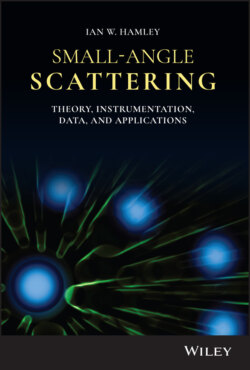Читать книгу Small-Angle Scattering - Ian W. Hamley - Страница 14
1.3.2 Isotropic Scattering Systems
ОглавлениеFor isotropic scattering the scattered intensity will only be a function of the wavenumber q and an orientational average (indicated by <..>Ω) is performed, i.e. Eq. (1.5) becomes
(1.11)
where rjk = rj − rk.
The average over all orientations of rjk can be evaluated as follows
(1.12)
This leads to the Debye equation for scattering from an isotropically averaged ensemble:
(1.13)
Considering a continuous distribution of scattering density, the orientational averaging of Eq. (1.12) has to be performed over Δρ(r) since it is a function of r:
(1.14)
The isotropic average of Eq. (1.14) leads, via Eq. (1.12), to
(1.15)
Here, Dmax is the maximum dimension of a particle (maximum distance from the geometric centre).
In terms of the isotropically averaged autocorrelation function γ(r) this can be written as
(1.16)
Or in terms of the Debye correlation function Γ(r):
(1.17)
This then leads to the expression
(1.18)
Here p(r) = Γ(r)r2 is the pair distance distribution function (PDDF). This is an important quantity in SAS data analysis since as can be seen from Eq. (1.18), it is related to the intensity via an indirect Fourier transform:
(1.19)
The PDDF provides information on the shape of particles, as well as their maximum dimension Dmax. Figure 1.3 compares the PDDF of different shaped objects.
Figure 1.3 Sketches of pair distance distribution functions for the colour‐coded particle shapes shown with a Dmax = 10 nm.
Source: Adapted from Ref. [9].
Many SAS data analysis software packages such as ATSAS and others (Table 2.2) and software on synchrotron beamlines is able to compute PDDFs from measured data. Methods to obtain PDDFs by indirect Fourier transform methods are discussed further in Section 4.6.1.
The radius of gyration can be obtained from p(r) via the second moment [4, 7, 10, 11]:
(1.20)
